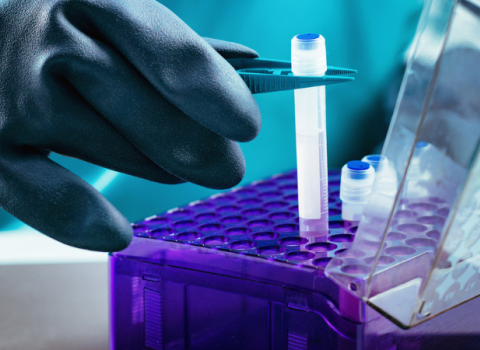By helping prevent, diagnose and manage bacterial infections, new medical technologies could curb overuse of antibiotics, slowing the spread of antimicrobial resistance

The rise of bacteria and fungi resistant to hitherto lifesaving antibiotics presents one of the world’s most pressing public health challenges. But new medical technologies—medtech—could help to slow the spread of these disease-causing superbugs both by preventing infections in the first place and by improving treatment.
Antimicrobial-resistant superbugs evolve through natural selection: over time, bacterial species develop resistance to the antibiotics that killed their forebears. Overuse of antibiotics accelerates the process, making it harder for medical science to keep up and adapt. Superbugs often strike in hospitals, where many patients require antibiotics and many more are vulnerable to hospital-acquired infections. Around 33,000 Europeans die from drug-resistant infections each year, while 37,000 people in Europe die every year from infections they picked-up while in hospital.
New medical technologies can help manage infections and reduce overuse of antibiotics in multiple ways, according to a recent position paper by the trade association MedTech Europe, published ahead of European Antibiotic Awareness Day (18 November). The paper calls on policymakers to step-up efforts to deploy medtech in the fight against antimicrobial resistance. For example, it recommends that the European Commission, as well as member states, support the development of new funding and business models that will improve access to new infection prevention and management tools. The paper notes that the extra healthcare costs and productivity losses due to multidrug-resistant bacteria in Europe amount to 1.5 billion euros a year.
COVID-19 pressure compounds the problem
New rapid testing kits could, for example, help reduce the number of COVID-19 patients that are needlessly given antibiotics. COVID-19 is caused by a virus, rather than bacteria, and antibiotics are useless against all viruses. Even so, a recent study found over 70% of COVID patients admitted to hospital are treated with them, whereas less than 10% were shown to also have a bacterial or fungal infection.
Many viral and bacterial respiratory diseases— including COVID-19—have similar symptoms, and COVID-19 can be worsened by a bacterial infection. With incomplete diagnostic information and under pressure to reduce risk, doctors often over-prescribe antibiotics.
Medtech can help, in the first instance, as diagnostic tools. For example, rapid polymerase chain reaction (PCR) test kits can help clinicians confirm or rule-out suspected viral and bacterial causes, supporting faster and more accurate diagnoses. If the infection is viral, they know not to use antibiotics; if it’s confirmed to be bacterial, automated antibiotic susceptibility testing can determine which antibiotic will be most effective.
Medtech promises to make hospitals safer
Advances in medtech could also help prevent patients from getting infected in hospital, which would both reduce deaths and the deployment of antibiotics, curbing the general risk of antimicrobial resistance. For example, closed-catheter systems can prevent bacteria or fungi from getting into intravascular catheters and causing serious bloodborne infections, which can make patients gravely ill. Around a third of intensive care patients with this type of infection die. New pre-filled saline drips can also reduce the risk of infected solutions.
Other innovations could also bring down the proportion of operations (about six per cent) that result in the patient becoming infected during surgery. For instance, active patient warming blankets can prevent hypothermia, which is a significant risk factor for infection during surgery. Some of the materials used in surgery can also be coated with antimicrobial agents to prevent infection, including gowns, incision drapes, sutures and implants. Low-temperature sterilisation products can also decontaminate any sensitive instruments that would be damaged by boiling water, the conventional way of sterilising surgical implements.
Moreover, medtech can help prevent and manage infection after patients are discharged from hospital. Advanced antimicrobial dressings can prevent wounds from becoming infected by providing a barrier against bacterial entry. Home-use medical technologies can also detect bacterial infections early, so that they can be eliminated before they develop and spread. Digital solutions, such as smartphone apps, can help ensure patients are keeping up with infection-prevention measures, such as changing the dressings on their wounds.
Equipping clinicians with better tools
Medtech products are diverse and so are the conditions they’re applied to, so decisions to use them will be made on the ground by clinicians. But there are steps policymakers can take to make sure healthcare practitioners have what they need at their disposal when trying to prevent hospital-acquired infections and reduce the threat posed by antimicrobial resistance.
To that end, the new MedTech Europe position paper recommends that the EU reinforce the link to infection prevention and management in the implementation of its current One Health action plan on antimicrobial resistance. It also calls on the European Centre for Disease Control and Prevention to provide evidence-based guidance on infection control, informed by detailed surveillance and reporting mechanisms in all member states.
Such measures are necessary, the paper argues, because the world is at risk of going back to a ‘pre-antibiotic era’, where patients could die from simple bacterial infections and life-saving treatments can no longer be performed safely.





 A unique international forum for public research organisations and companies to connect their external engagement with strategic interests around their R&D system.
A unique international forum for public research organisations and companies to connect their external engagement with strategic interests around their R&D system.